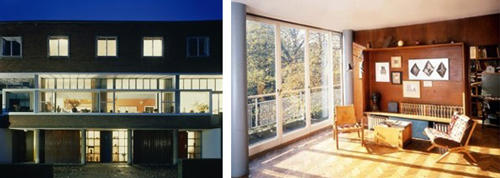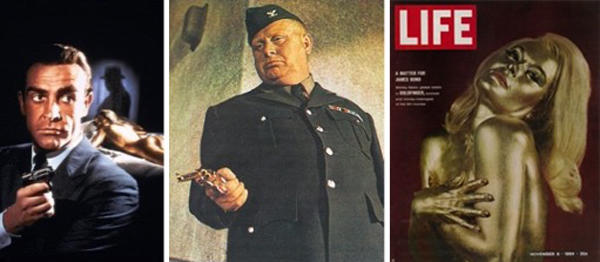Was the Model for Ian Fleming's Goldfinger Responsible for Urban Reconstruction Plans in Postwar Britain?
--Ian Fleming vs. Ernö Goldfinger
Yumiko Fukunishi
Professor, Faculty of Commerce, Chuo University
Areas of Specialization: British Cultural History and Literature
On Her Majesty's Secret Service
As everybody knows, James Bond is an agent in the British Secret Service who defeated nefarious villains from eastern Europe and east Asia against the backdrop of the Cold War. He appeared in a series of spy novels (1953-1966) by the British author Ian Fleming (1908-1964). Bond is said to have been modeled on Fleming himself, who was a special member of the UK's Naval Intelligence Division and the MI6 Secret Intelligence Service during World War II. The James Bond series is still hugely popular both in the UK and abroad, with almost all the novels having been made into films. At the opening ceremony of the 2012 London Olympics, the actor Daniel Craig as James Bond escorted Queen Elizabeth II to the stadium.
Model for the villain in a James Bond novel-The long journey of Ernö Goldfinger
The evil Auric Goldfinger appears in the seventh novel in the James Bond series (it was published in 1959 and the film based on it was released in 1965). Goldfinger is a Jew from Russia and like other villains in the series, his lust for money and power leads him into a deadly battle with Bond. In fact, Auric Goldfinger was inspired by a real man with the same surname. In this article, I would like to focus on that man, the real-life architect Ernö Goldfinger (1902-87). I will discuss his life, his work, and his connection to Fleming.
Urban development and high-rise buildings by Goldfinger
Goldfinger, a member of the first generation of modernist architects, had a significant impact on architects much younger than him during the Brutalist period(i) after World War II. Born into a Jewish family in Budapest, Goldfinger moved to Vienna with his family in 1919. After being educated in Switzerland and Paris, he enrolled in the Parisian art school École des Beaux-Arts to study architecture. However, the conservative style of the school did not suit him, and consequently, he turned to established architects such as Auguste Perret and Le Corbusier for guidance. In 1934, he married Ursula Blackwell, a British art student whom he had met in Paris in 1932, and together they moved to London. Goldfinger joined the MARS Group (Modern Architectural Research Society) and deepened his interactions with radical young British architects such as Wells Coates, as well as Walter Gropius, Berthold Lubetkin, and other architects who had fled countries such as Germany and Russia. Goldfinger lived in a house in Hampstead (2 Willow Road) he had designed for 50 years until his death. Although his straight-lined terraced house made of bare red brick and concrete, was designed to blend in with the surrounding early 19th-century dwellings, it was the subject of strong criticism from neighbors who claimed that it would spoil the aesthetics of the road.

Left/right photographs: Goldfinger's private residence. Unlike the plain, straight-lined exterior, the interior is warmly decorated with plenty of wood. It is currently managed and operated by the National Trust.
During World War II, Goldfinger worked on ambitious plans to redevelop a London cityscape that had been damaged by bombing but the projects he undertook in the ten years or so after the war were on a much smaller scale. Notable buildings from this time include the headquarters for the Daily Worker in Clerkenwell, London (1946), and the office for Carr & Company in Shirley, Birmingham (1956). (The latter project was clearly inspired by Le Corbusier's Unité d'Habitation.) Goldfinger's work was recognized by Alison and Peter Smithson, who were pioneering architects in the Brutalist school and through their support, Goldfinger was able to exhibit at the 1956 "This is Tomorrow" exhibition at the Whitechapel Art Gallery.
In 1959, Goldfinger got the opportunity to work on a large-scale project to redevelop the Elephant and Castle area in London and in the 1960s, he was commissioned to develop the residential districts of Poplar in East London and then North Kensington in West London. These two districts are home to Goldfinger's most famous (and infamous, for their enormous size) structures--the Balfron Tower in Poplar and Trellick Tower in North Kensington. The towers have been designated as Grade II* listed buildings (structures of special interest, warranting every effort to preserve them).
In a 1956 letter to The Guardian, Goldfinger wrote: "The goal of high-rise buildings is to free the ground for children and adults to enjoy Mother Earth, not to cover every corner with bricks and mortar." By fulfilling this vision, Goldfinger became one of Britain's most famous modernist architects of the 20th century(ii).

Left: Goldfinger standing in front of the Balfron Tower.
Middle: Mr. and Mrs. Goldfinger on the balcony on the top floor of the Balfron Tower. In his dystopian 1975 novel High Rise, J.G. Ballard, through the character Anthony Royal, ironically depicts the lifestyle of an architect who rules over high-rise condominiums, living in a top-floor penthouse and partying through the night while looking down on lower floors.
Right: The Trellick Tower still stands in North Kensington. 98 meters high and with 31 floors, the tower is said to be a masterpiece of Brutalist architecture. Originally used as public housing, some of the units were renovated and sold to the wealthy.
Fleming vs. Goldfinger
As is frequently the case with authors, Ian Fleming often took inspiration from real life when naming his characters. It is well-known that the name "James Bond" was taken from the author of an ornithology book which Fleming happened to read. But what about Auric Goldfinger? Fleming is said to have first heard the name "Goldfinger" during a golf round with John Blackwell, a cousin of Ernö Goldfinger's wife Ursula, and decided to "borrow" it(iii).
Ernö Goldfinger is said to have been very tall and somewhat humorless. He was born in a Jewish family in Hungary and later acquired British nationality. The fictional Auric Goldfinger was different in some ways - he was a short Jewish Soviet agent - but like Ernö, he was also naturalized British while remaining essentially a foreigner without English social skills.
When he found out about the novel, the real Goldfinger suspected Fleming had decided to use his name after talking to his wife's cousin. He was an avid Marxist, designing the headquarters of the Communist Party magazine Daily Worker as mentioned above but in spite of his sympathy for the USSR, he was not happy to have a ruthless Soviet agent based upon him. Goldfinger's lawyer immediately sent a letter to Fleming's publisher Jonathan Cape protesting that Goldfinger's reputation had been damaged by the use of his name as the villain in the James Bond novel. "Goldfinger" was a rare and very distinctive family name in Britain and Jonathan Cape was worried, hurriedly consulting Fleming, fearing delays in the publication of Goldfinger and subsequent loss of revenue. Fleming, who happened to be in Jamaica at the time, was very angered by the architect's accusation. Fleming pointed out that the surname "Goldfinger" was listed many times in telephone books in the United States and Germany. "The accusation from Goldfinger is nonsense. Include a note within the already printed copies of the book changing the name to Goldprick, and write the reason for the change," said Fleming when responding to his publishing company (this change was not made.)(iv). Fortunately, adding the disclaimer "All characters are fictitious" to the first edition of the novel and sending six copies of the first edition to Ernö Goldfinger, somehow managed to calm the tempers and a solution was reached.
There is a theory that Fleming, a resident of Hampstead, disliked the uncompromising and unprecedented modernist terrace houses built by Goldfinger on Willow Road in the lush green district, which made him seek revenge against him. However, there is nothing to corroborate this story, nor is there any evidence that Fleming ever expressed views on modernist architecture. Nevertheless, it is true that Fleming despised Goldfinger's political beliefs and when considering their respective lives and personalities, it is easy to understand why there might have been tension between the two men. The only sure truth is that Fleming loved the name "Goldfinger." Just like his use of the name "James Bond," Fleming simply could not resist giving one of his characters a real person's name.

Left: Sean Connery, the first actor to play Bond.
Middle: Gert Fröbe, the actor who played Goldfinger in Goldfinger.
Right: Shirley Eaton was featured on the cover of an American magazine Life, painted in gold to create a striking image (November 6, 1964).
Conclusion
Ernö Goldfinger was an architect who fought with a best-selling author and designed controversial buildings which garnered a wide range of opinions regarding their beauty (or lack thereof). For better or worse, Goldfinger left the image of the architect as an all-powerful being. Even today, Goldfinger's extraordinary vision remains imprinted on the cityscape of London. Once the COVID-19 pandemic ends and if you have a chance to visit London, I recommend visiting Goldfinger's home in Hampstead, and looking at his high-rise buildings. Please judge the beauty or ugliness of these structures with your own eyes.
Notes
i: Brutalist is an architectural philosophy and style that aims to use direct and raw materials. It is characterized by a rough concrete finish, which Le Corbusier referred to as béton brut (French for "raw concrete"). Brutalism flourished from the 1950s to the 70s.
ii: Alexander Clement, Brutalism: Post-War British Architecture (Wiltshire: The Crowood Press, 2018) 95.
iii: John Cork, 'Introduction', Ian Fleming, Goldfinger (1959; London: Vintage Books, 2017) xviii.
iv: Fergus Fleming, The Man with the Golden Typewriter (London: Bloomsbury, 2015) 207-8.
Yumiko Fukunishi
Professor, Faculty of Commerce, Chuo University
Areas of Specialization: British Cultural History and LiteratureYumiko Fukunishi was born in Osaka Prefecture. In 1998, she graduated from the Department of English, the College of Liberal Arts, Tsuda University. She completed her MPhil in contemporary history (20th century British history) in the School of Historical Studies, the University of Birmingham. She completed the Doctoral Program in the Department of Interdisciplinary Cultural Studies (Culture and Representation Course), the Graduate School of Arts and Sciences, the University of Tokyo. She was a visiting research fellow in the School of History, Queen Mary University of London (2018 to 2019). She served as an Assistant Professor and Associate Professor in the Faculty of Commerce, Chuo University before assuming her current position in 2020.
Her current research themes are contemporary British cultural history and literary studies (mainly British journalism, literature, architecture, and art since the 1930s). Her major publications include British Literature and Film (Chuo University Press, 2019; co-authored), The Challenge of British Middlebrow Cultural Studies (Chuo University Press, 2018; co-authored) and Love and War in British Cultural History―1951 to 2010 (Keio University Press, 2011; co-authored).









